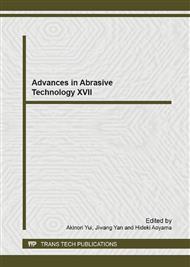p.669
p.675
p.681
p.686
p.692
p.696
p.705
p.709
p.715
Estimation of Machining Error in Ball-End Milling of Hemispherical Surface Based on Measured Cutting Force
Abstract:
For a cutting process using a low-rigidity end mill, it is very important to be able to estimate the degree of machining error caused by the deflection of the tool. The purpose of this study is to establish a method of estimating, in real time, the machining error caused by the deflection at the cutting point of an end mill. To this end, in this research, a method for estimating the machining error caused by the deflection of the tool used for the ball-end milling of a hemispherical surface was verified by comparing the estimated and measured deflections of the tool. As a result, it was found that the machining errors in ball-end milling could be estimated from the normal force at the moment when the radial direction of the peripheral cutting edge is normal to the feed direction of the tool.
Info:
Periodical:
Pages:
692-695
Citation:
Online since:
September 2014
Keywords:
Price:
Сopyright:
© 2014 Trans Tech Publications Ltd. All Rights Reserved
Share:
Citation:


